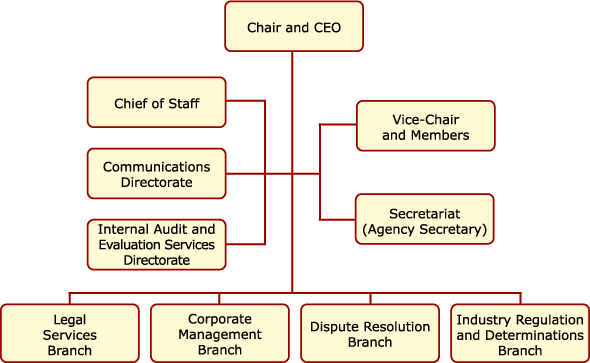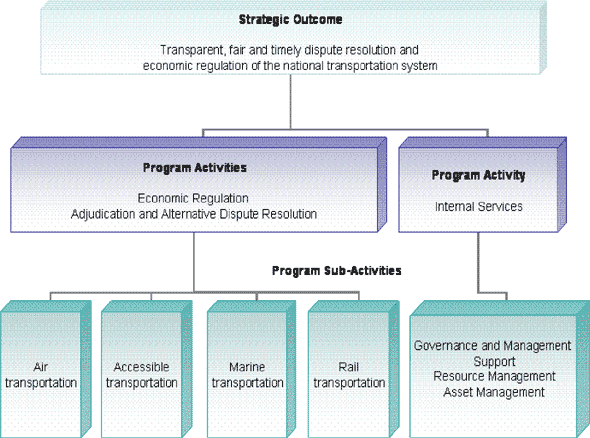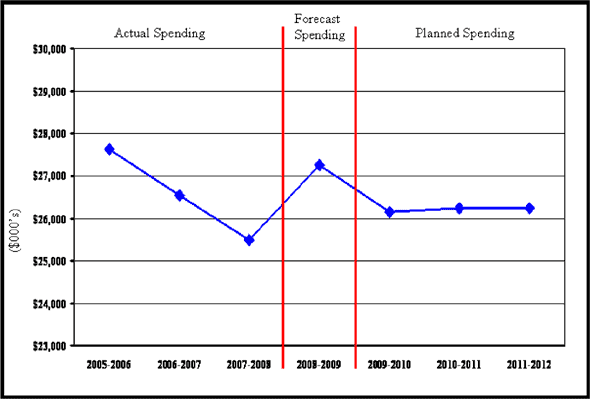Common menu bar links
Breadcrumb Trail
ARCHIVED - Canadian Transportation Agency
 This page has been archived.
This page has been archived.
Archived Content
Information identified as archived on the Web is for reference, research or recordkeeping purposes. It has not been altered or updated after the date of archiving. Web pages that are archived on the Web are not subject to the Government of Canada Web Standards. As per the Communications Policy of the Government of Canada, you can request alternate formats on the "Contact Us" page.
Chair's Message
I am pleased to present the 2009–2010 Canadian Transportation Agency Report on Plans and Priorities. This report will outline our commitment to delivering high-quality services, and the Agency's contribution to the Government of Canada's objectives.
The end of this reporting period will mark the halfway point in the Agency's first-ever, multi-year Strategic Plan (2008-2011). Our Strategic Plan, supported by a comprehensive Action Plan, is focussed on ensuring that we deliver on our mandate as set out in the Canadia Transportation Act and is guided by our mission – to assist in achieving a competitive, efficient and accessible transportation system through fair, transparent and timely dispute resolution, essential economic regulation and communication.
The Agency is also taking actions to respond to the Government of Canada's objective of making federal institutions more effective. We have established challenging multi-year performance standards, targets and improvement action plans for each of the Agency's key business lines and corporate service functions. To strengthen our ability to manage growing and changing workload demands and meet new legislative responsibilities, we also undertook a major organizational restructuring and resources reallocation. The new structure integrated the former modal approach (air, rail, marine and accessible transportation) into a functional business delivery model.
We are also expanding our efforts and capacity to reduce costs for both the Agency and disputing parties through Alternative Dispute Resolution (ADR) mechanisms such as facilitation and mediation. And we will be pursuing a number of business management initiatives, including measures to address critical staff retention and recruitment issues and technological upgrades, designed to achieve enhanced resources utilization and client services improvement objectives.
The last year was marked by our efforts to put in place the new organizational structure, initiating reviews of key business processes, establishing performance measures and targets, and developing a strategy for human resources renewal. I believe 2009-10 will be marked by clear and measurable progress and results in support of our commitments to the Government's and the Agency's objectives and priorities.
Geoffrey C. Hare
Chair and Chief Executive Officer
Section I — Overview
1.1 Raison d'être
As an independent, quasi-judicial tribunal, the Agency makes decisions on a wide range of matters involving air, rail and marine modes of transportation under the legislative authority of Parliament and, for certain accessibility matters, extra-provincial bus transportation). Most of the Agency's activities and workload are generated by demand from users and operators of the national transportation system. The Agency implements the transportation policy established by Parliament in the Canada Transportation Act and other legislation. The tribunal's decision-making process is governed by its General Rules, which ensure that all parties to a complaint or an application are dealt with fairly and equitably.
The Agency's mission is to assist in achieving a competitive, efficient and accessible transportation system through dispute resolution, essential economic regulation and communication in a fair, transparent and timely manner.
1.2 Organizational Information
The Agency exercises its powers through its Members, who are appointed by the Governor in Council (GIC). The GIC may appoint up to five Members, of which one shall be designated Chair and Chief Executive Officer (CEO), and one Vice-Chair. The Minister of Transport, Infrastructure and Communities can also appoint up to three temporary Members.
The Chair and CEO is accountable for the Agency's three program activities. The Vice-Chair replaces the Chair and CEO during his absence. All Agency Members are accountable for making quasi-judicial decisions on matters before the Agency.
The Agency performs the functions vested in it by the Canada Transportation Act and related legislation (refer to section 3.2.3 for a list of legislation and regulations that the Agency administers in whole or in part). It operates within the context of the very large and complex Canadian transportation system (for details, refer to Transport Canada's Web site at http://www.tc.gc.ca).
The Agency is one of many Canadian partners helping to achieve transportation that works for everyone by contributing to a competitive and accessible transportation system that efficiently meets the needs of users and service providers and the Canadian economy. Its responsibilities include:
- Economic regulation, to provide approvals and licences, and make decisions on a wide range of matters involving federally regulated air, rail and marine transportation;
- Dispute resolution, to resolve complaints about transportation services, rates, fees and charges; and
- Accessibility, to ensure that our national transportation network is accessible to all persons, particularly those with disabilities.
The Agency's organizational structure is composed of four branches: the Dispute Resolution Branch, the Industry Regulation and Determinations Branch, the Legal Services Branch, and the Corporate Management Branch. The heads of each branch, as well as the Communications Directorate, Internal Audit and Evaluation Services Directorate, and the Secretariat Directorate, report directly to the Chair. The new structure integrates a modal approach (air, accessible, rail, and marine) within a functional business delivery model and allows the Agency to better deal with workload and resource challenges. It provides more flexibility to better respond to change and allows resources to be reallocated where needed to address evolving workload demands. It creates a better place to work, with greater career opportunities, learning and professional development, more variety in work assignments, and better internal mobility for employees between directorates and branches. And finally, it helps address new client-driven demands resulting from the legislated amendments contained in the Canada Transportation Act.

The Canadian Transportation Agency manages the economic regulation of air, rail and marine modes of transportation under the legislative authority of Parliament through the administration of laws, regulations, voluntary codes of practice and educational and outreach programs and through the resolution of disputes. It is an independent quasi-judicial administrative tribunal reporting to the Parliament of Canada through the Minister of Transport, Infrastructure and Communities.
All decisions on matters before the Agency, whether they relate to air, rail, marine, or accessible transportation matters, are made by Agency Members appointed by the Governor in Council.
1.3 Program Activity Architecture
The Canadian Transportation Agency's Program Activity Architecture (PAA) has a single focus. The Agency pursues one strategic outcome:
Transparent, fair and timely dispute resolution and economic regulation of the national transportation system.
This is achieved through three program activities:
| Program Activity | Expected Result |
|---|---|
| Economic Regulation | Economic and other interests of transportation users, service providers and other affected parties are protected. |
| Adjudication and Alternative Dispute Resolution | Access to a specialized dispute resolution system that is cost-effective, responsive, fair and timely, and serves the needs of users, service providers and other affected parties within the national transportation system. |
| Internal Services | Support the needs of programs and other corporate obligations of the Agency. |

Program Activity Crosswalk
As approved by Treasury Board, the Agency modified its PAA for 2009–2010 with the following change to its program activities:
| 2008–2009 | 2009–2010 |
|---|---|
| Economic regulation of the federal transportation system. |
Economic Regulation Adjudication and Alternative Dispute Resolution Internal Services |
The one program activity was divided into three program activities following changes to the Agency's organization structure. The Agency regulates the national transportation system (air, rail and marine) through the administration of laws, regulations, voluntary codes of practice, education and outreach programs, and adjudicates disputes between users of, service providers within and others affected by the national transportation system. With this clear distinction between activities, the expected results, performance measures and resource requirements are more closely linked to how the Agency delivers its mandate.
Risk Analysis
The Agency continues to face fundamental workload challenges as a result of increased responsibilities, more complex cases, a limited budget, and anticipated retirements over the next three years. The new organizational structure is intended to address challenges faced by the Agency by improving process efficiency to ensure the optimum use and realignment of resources that will match priorities and workload to meet future challenges.
With the entrenchment of its mediation services in the Canada Transportation Act, the Agency has created an ADR Services unit and developed guidelines to divide its approach to dispute resolution into two separate processes: informal and formal. The document encourages the resolution of disputes informally and promotes the use of facilitation and mediation as the preferred options for resolving disputes and issues before moving into the formal process.
The Agency strives to be an innovative, knowledge-based organization, enabling it to effectively deal with the challenges of a changing environment and allowing it to be more responsive to Canadians and national economic objectives. Internal audits and business process evaluations will provide objective assessments of the design of our practices and operation of our systems and directly contribute to effective risk management and resource control as part of the Agency's commitment to continuous improvement in its planning and operations. Education and consultation are integral to the Agency's effectiveness. The Agency works closely with those who use and provide transportation services in Canada and those outside Canada that are directly affected by these services. The Agency helps travellers, shippers, air carriers, municipalities and others to fully understand not only their rights and obligations, but also the Agency's roles and responsibilities. The Agency consults as widely as possible on issues related to the administration of its legislated mandate. By remaining open and by listening to all affected parties, the Agency ensures that its decisions are both responsive and responsible.
The Agency contributes to improving access to the federal transportation system for all Canadians. As Canada's population ages and the incidence of disability increases, the demand for accessible transportation will be even greater. The Canada Transportation Act includes a role for the Agency regarding the accessibility of the federal transportation network. The Agency is committed to ensuring the transportation network is accessible without undue obstacles to the mobility of persons, including persons with disabilities.
The Agency will continue to focus on strengthening its relationships with its various co-delivery partners through fostering its close ties and working relationships with Transport Canada, Foreign Affairs and International Trade Canada, the Canada Border Services Agency, the Canadian Human Rights Commission, the Canadian Air Transport Security Authority, and a number of provincial governments. For details on these relationships, refer to the Agency's Web site at http://www.cta.gc.ca/about-nous/partners_e.html.
1.4 Expenditure Profile

Actual spending declined from $27.6 million in 2005–2006 to $25.5 million in 2007–2008 and is explained by the following:
- the elimination of funding, in the amount of $2.6 million, for the Office of the Air Travel Complaints Commissioner, which was phased over a three-year period beginning in 2005–2006; and
- an extensive internal review process focussed on improving management of our work, delivering more timely decisions, and improving caseload management was conducted in 2006–2007. This process led to the implementation of a new organizational structure and resulted in a resource reallocation exercise. The Agency's ability to recruit accountants, financial analysts and economists was limited as a result of reduced availability of these professional groups.
Forecast spending in 2008–2009 is higher by $1.8 million over 2007–2008 actual expenditures due to the $1.1 million for the 2007–2008 carry forward and $0.6 million for costs associated with the implementation of the new organization structure.
Planned spending for 2009–2010 and future years is lower than the 2008–2009 forecast spending by $1.1 million, as it does not reflect the Agency's maximum carry forward which is included in 2008–2009 amount.
1.5 Planning Summary
1.5.1 Financial Resources ($ thousands)
| 2009–2010 | 2010–2011 | 2011–2012 |
|---|---|---|
| 26,152 | 26,151 | 26,151 |
1.5.2 Human Resources (full-time equivalents)
| 2009–2010 | 2010–2011 | 2011–2012 |
|---|---|---|
| 252 | 252 | 252 |
1.5.3 Link to the Government of Canada Outcome Areas
The Agency's strategic outcome and program activity are directly aligned with the broader Government of Canada outcome of “a fair and secure marketplace”. The regulatory programs implemented by the Agency resolve economic issues, remove transportation barriers and protect the rights of consumers, carriers and others. These programs also help to improve the overall quality of life in Canada, as an efficient and accessible transportation system that benefits all Canadians.
| Program Activity | Forecast Spending 2008–2009 | Planned Spending | Alignment to Government of Canada Outcome Area | ||
|---|---|---|---|---|---|
| 2009–2010 | 2010–2011 | 2011–2012 | |||
| Economic Regulation | 11,993 | 11,902 | 11,942 | 11,942 |
A fair and secure marketplace |
| Adjudication and Alternative Dispute Resolution | 7,132 | 6,584 | 6,564 | 6,564 | |
|
Internal Services |
8,100 | 7,666 | 7,645 | 7,645 | |
| Total Planned Spending | 27,255 | 26,152 | 26,151 | 26,151 | |
1.5.4 Voted and Statutory Items in Main Estimates ($ thousands)
| Vote or Statutory Item | Truncated Vote or Statutory Wording | 2009–2010 Main Estimates | 2008–2009 Main Estimates |
|---|---|---|---|
| 25 | Program expenditures | 22,933 | 22,611 |
| (S) | Contributions to employee benefit plans | 3,219 | 3,444 |
| Total for the Agency | 26,152 | 26,055 |
Contribution of Priorities to Strategic Outcome
The Agency's Strategic Plan is based on an overarching objective to maintain and enhance the Agency's long-standing reputation as a leading Canadian tribunal by committing to set and achieve high performance standards. The Agency will focus on five organizational priorities as follows:
1. Effective dispute resolution and economic regulation
The Agency acts early to define issues, identify the interests involved and bring together the parties in a dispute. Through collaborative mechanisms, results will be achieved faster and more effectively, at less cost and with greater satisfaction and commitment to solutions. Where possible, the Agency encourages voluntary and informal processes to resolve disputes between parties as a more effective means of resolving disputes. Adjudicated cases are dealt with through an impartial, transparent, timely and fair process. While the national transportation policy encourages the market to regulate itself where competition exists, it acknowledges that regulation is necessary where parties are not served by effective competition. The Agency has a mandate to administer economic regulatory provisions affecting modes of transport under federal jurisdiction as described in various Acts of Parliament. The Agency issues administrative rulings and determinations, many of which are complex and unique, to support the effective regulation of the national transportation system.
2. Focussing on People
Employees are the Agency's greatest asset. The Agency strives to create a working environment that fosters innovation and creativity, and creates opportunities for development to attract and retain highly skilled individuals and to be recognized as a workplace of choice. The focus is on the recruitment, the retention and the development of competent, capable and high performing staff.
3. Enhanced Internal and External Relations
To establish productive and mutually beneficial relationships with its clients, its stakeholders and its employees, the Agency recognizes the need to commit to clear and timely communications. It has adopted an approach that is co-ordinated and designed to improve its understanding of the issues and challenges facing its employees, clients and transportation service providers.
4. Accessible Transportation
The Agency uses a variety of mechanisms to improve the accessibility of the federally regulated transportation network to persons with disabilities. It tries to eliminate problems before they occur by responding to pre-travel inquiries and by educating all parties about their rights and responsibilities regarding the accessibility of the federal transportation network. It develops and promotes regulations, codes of practice and standards that offer practical, functional and operation-oriented solutions. When disputes do occur, the Agency moves to resolve them quickly, encouraging collaborative approaches where possible.
5. Organizational Support and Responsiveness
With a strong governance model, effective management principles and sound processes, the Agency is an effectively managed and forward-looking, innovative organization that anticipates and responds effectively to change.
The Agency's 2008–2011 Strategic Plan is reviewed and updated on an annual basis. For planning and forecasting purposes, we anticipate that the strategic priorities and actions that fall outside of the time horizon of the current strategic plan will not be substantially different. Accordingly, the resources required will remain stable. The process for establishing strategic priorities and actions for 2011–2014 will take place in 2010.
